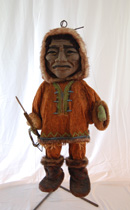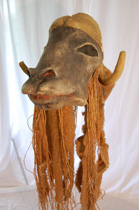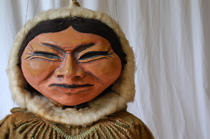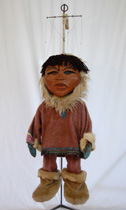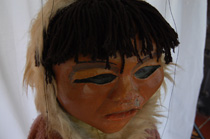 INOOK AND THE SUN, 1973
INOOK AND THE SUN, 1973
Texte : Henry Beissel
Concept, marionnettes : Felix Mirbt
Mise en scène: Felix Mirbt, Jean Herbiet
Voici ci-dessous une sélection d'écrits de Felix Mirbt directement liés à la pièce Inook and the Sun ou en écho à son travail sur cette production, ainsi qu'une critique publiée lors de la création en 1973.
STRENGTH
When you work with emotions (especially your own) you can't give it to the character - when you detach yourself - and keep clear beats in your reading (with a metronome yet) you have control - which (equals and) projects itself as strength.
INOOK and the SUN (1973)
A puppet play for children by Henry Beissel.
After insulting the SPIRIT OF THE CARIBOU, INOOK has to find the SUN, before he can eat again. Not only is his prowess as a hunter tested when a POLAR BEAR kills his FATHER, but he also has to brave the angry SPIRIT OF THE MOON and the SPIRIT OF THE WIND. And before he finally meets the SUN he confronts SUMA, the Goddess of the sea, fights the SEA MONSTER, who cannot see and outwits the two FEROCIOUS SHARKS. And when in the end he meets the SUN, she teaches him that each must have its season, sun.. moon.. wind. And each year he has to let go his bride, the SUN, for the winter is cold and she needs to warm the fish under the ice. That is the burden of understanding, that is the burden of growing up.
Co-directed by Jean Herbiet and Felix Mirbt
I found in Jean Herbiet a supportive collaborator who supported my trying OPEN MANIPULATION of the large marionettes. We decided on a clear separation of (visible) VOICES and (visible) MANIPULATORS. The VOICES walked along with the puppet (and the manipulators). And the technical staff created live sounds (they wanted to be part of it too).
"If you could have your pick of the Stratford, Ont. season for an opening in Chicago next week, what would you choose?" asked a friend. The answer was easy. Not Shakespeare, Goldsmith, or Gogol. Not that marathon music Sunday. Not the experimental opera, "The Exiles", for all its imaginative use of controlled improvisation and projected graphic scores. What I would give a lot to see here next week, next year, or anytime, is "Inook and the Sun".
Stratford's Inook takes place in the Arctic, and its simple bi-level stage is appropriately white, as are the costumes of the live performers and puppeteers. In this bright arena, the simplest fragment or symbol - a snowflake, row of waves, or projected shaft of moonlight - is sufficient setting. Felix Mirbt's creations are more than dolls. His Inuit family has its dog sled and teams of yapping huskies. A feisty arctic fox plays hide and seek around lumbering pairs of musk-oxen. Seals on long wands cavort in formation. A sea-monster sprouts tentacles everywhere.
And the gigantic polar bear which kills Inook's father in the midst of their hunting trip is a truly terrifying giant. As the humans and animals play out their roles front and centre, the speaking actors and actresses range the upper level.
Inook's adventure takes him into the spirit world, where sun, moon, wind, ice, and other familiar realities have voices. For these, the production uses mimes in striking masks. Like the silent operators, they surround and dwarf the child and his animal friends, but leave their voices to the actors. The operators handle the puppets with a blend of affection, gentleness, and precision. Inook asleep breathes softly, then fidgets as he dreams. Lying on his stomach for a chat with a musk-ox, he wiggles a foot like small boys everywhere. The spear with which he dispatches the polar bear is held by an operator - the puppet's hands are also gloves - but so carefully is weight and thrust regulated that we do not notice the human assistance.
The tale is a timeless one, of a boy who rebels at the natural order, answers a riddle, does a brave deed, survives his father's death, and is awarded, for half of each year, anyway, the sun as his bride.
At the third stage, a special area was marked off for small children to sit close up, while the rest of us were employed on steeply raked bleachers. Like the rest of us, they appeared to be spellbound by the richness, variety, and effectiveness of what they were seeing and hearing."
Thomas Willis, Chicago Tribune, 22.8.1973
INOOK A RITUAL - June 19, 1994
THE KILLING OF THE POLAR BEAR (and father)
It was during INOOK rehearsals in Stratford that we ran into the problem of killing the polar bear. Traditionally it takes two hunters to kill a polar bear, because the animal is too fast for one person; the second hunter has to attack from the back in order to diffuse the attention of the beast.
Ours, the puppet, was seven feet high and needed two manipulators to make it move. In our play FATHER and INOOK are attacked by the bear and all our skilled manipulation and inventive ideas about the fight and the final KILL with harpoons and other props never looked real, never looked like a fight and the final killing. Even the irreverent approach did not help and ended rehearsal in gales of laughter. And so we looked at our approach: how about commenting / telling the hunt, how about retelling the story of the hunt and how about the song, the chant of the kill? Ultimately it became a dance, a ritual of planned and slow steps, where a documentary reality was not observed, where everyone of us had his (and her) own feelings about The Kill. We developed a ritual of throwing our seven dogs at the bear and father attacking from the front. Father gets killed (a no-no for children stories in the seventies) and it allows INOOK his first kill. Jean Herbiet who co-directed with me, only said: you finally killed your father.
Actually the thought about this incident came through Almut stating, that it is I who is ultimately responsible for the administrative as well as the creative side in our life; and how difficult that sometimes seems to become, a thought I don't allow myself to think (self esteem). It probably was father’s dilemma not to have anybody to share that with him, I even wonder if he knew about it and if, why he never looked for counsel.
These are just some beginnings to touch the topic of FATHER. Amazing, he is still too monolithic, for even negative thoughts about him are difficult to fathom, to find, to state...
